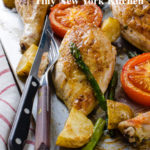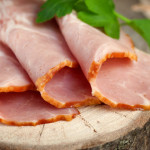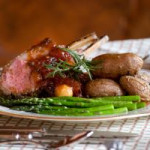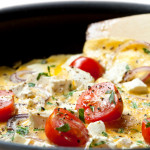Roasting refers to proteins and vegetables cooked mostly at high temperatures in the oven. Baking uses a lower temperature to cook breads, baked goods, and casseroles.
Roasting makes any vegetable taste better. It brings out their flavor, caramelizes their natural sugars, and adds crunch. If your family doesn’t love certain vegetables like broccoli or Brussels sprouts, roasting is a great way to change their mind. Double what you’re roasting and then turn extra servings into quick meals later in the week. Cooking a little extra with one meal lets you make the most of value-sized packages of proteins and other store sales. With leftover already planned, you won’t need to lean on takeout.
Why we love to roast:
It’s Affordable! Inexpensive ingredients are tastiest when roasted. Root vegetables are browned and crisp, tomatoes and grapes are extra juicy and sweet, and tough cuts of beef are fall-apart tender. You also don’t need any special equipment to roast.
Roasting Is Healthful! Roasted foods need very little fat to cook compared to frying or sautéing. Roasting also intensifies flavors without added salt, sugar, or other ingredients.
It’s Easy! Roasted foods need little prep before they cook. And once the oven door closes, you can walk away. Fewer pans and utensils are needed, making cleanup easier too.
Essential Tools For Roasting:
Rimmed Sheet Pan: The rim keeps vegetables from falling off the sides and catches any juices from meats and fish.
Oven-Save Skillet: Go from stovetop to oven and back. Sear meats before roasting or make a pan sauce with the meat drippings after roasting.
Roasting Pan: Best for large roasts, hams, and turkeys. An inner rack lifts the meat so it can brown and crisp underneath.
Parchment Paper: Line pans to keep foods from burning and sticking, then toss for easy cleanup. If roasting at a higher temp or broiling use foil.
Metal Tongs: Flip and stir foods on a hot pan with ease. Look for tongs with a heat resistant grip.
Silicone Brush: Brush on a sticky glaze or baste foods with sauce. The silicone bristles are easy to clean.
Tips For Sheet Pan Roasting:
Jump Start Browning by preheating your sheet pan before adding vegetables.
Pat foods very dry with paper towels so the outside browns while the inside cooks through.
Cut foods to the same size and thickness so smaller pieces don’t burn.
Space out foods on the sheet pan so they have room to crisp and brown.
Let sheet pans cool before rinsing to keep the metal from warping.
©Tiny New York Kitchen © 2021 All Rights Reserved
The holiday season is in full swing and soon you’ll be living on Thanksgiving leftovers. Ever had pumpkin pie for breakfast followed by a full turkey meal for lunch and another for dinner? It’s easy to get in the habit of holiday indulging.
The average American gains more than a pound each holiday season. Over a decade that really adds up. As they say, “It’s easy to put it on and hard to take off.”
There are ways to enjoy the holidays, but keep yourself in check so that you don’t fall into the trap of complete abandon.
High Fat Foods
Pigs In A Blanket: High In Fat, Salt, and Carbs.
Fried Cheese Balls: High In Fat And Small So It’s Easy To Overeat.
Baked Brie: Fatty And Addictive, Plus You Have To Slather It Onto Some Carb Calories.
Chips: They Have No Nutritional
Eat In Moderation
Cheese And Crackers: Calorically Dense And Super Easy To Eat. They’re Not Special So Spend Your Holiday Calories On Something More Festive.
Once-A-Year Favorites: You Only Eat Stuffing, Latkes, And Eggnog Once Or Twice A Year. If You’ve Been Coveting Aunt Martha’s Chiffon Pie Or Cousin Tommy’s Cooked Goose, Enjoy In Moderation.
Be My Guest
Crispy, Crunchy Crudités: Make The Brightly Colored Vegetables Your First Stop For Noshing. Add Hummus To Slow Digestion.
Pork Tenderloin, Ham Or Turkey: Protein Is Going To Suppress Your Appetite Due To The Fact That It Is Slow Digesting And Triggers The Release Of Several Satiety Hormones.
Shrimp Cocktail: Low In Fat, High In Protein And A Perfect First Course For A Low Calorie Tour Of The Buffet.
Swedish Meatballs: Another Protein Packed Option That Stands Out Amid A Carbohydrate Heavy Table.
Prosciutto Wrapped Asparagus: A Great Choice To Fuel Your Body While Keeping Your Appetite In Check.
Enjoy the holidays, but enjoy them in moderation.
“Work With What You Got!”
© Victoria Hart Glavin Tiny New York Kitchen © 2017 All Rights Reserved
Cooking Ham
Ham is a great choice for spring gatherings. It’s simple, feeds a crowd and provides wonderful leftovers.
Keep Servings In Mind. Allow for 1/2 to 3/4 pound per serving for bone-in ham, and 1/4 to 1/2 pound per serving for boneless ham.
Before Cooking make sure to let ham sit at room temperature for approximately 1 hour.
Scoring The Skin adds to a beautiful presentation. Cut 1/4 inch deep crosswise into 1 to 2 inch squares to create classic diamond shapes.
Glaze The Ham during the final hour of cooking to avoid burning.
Keep The Flavor Going. Buying bone-in ham leaves you with the ham bone, which is great for flavoring soups and beans.
“Work With What You Got!”
© Victoria Hart Glavin Tiny New York Kitchen
Roasted Leg of Lamb Roman Style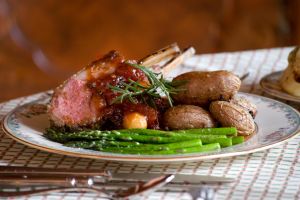
This is such an easy Sunday meal. For this traditional Roman dinner, purchase 1/4 of a nice fat “abbacchio”. In Rome “abbacchio” is a very young lamb, which has been fed only with milk. I usually purchase my “abbacchio” from a nice butcher in the Arthur Avenue area of the Bronx. If you don’t want to buy 1/4 of a young lamb then just get a decent sized leg of lamb that will accommodate the size of your family (make sure it’s not been previously frozen). Insert cloves of garlic, both lean and fatty ham, chopped stalks of rosemary, kosher salt, freshly ground pepper, and brush all over with olive oil. Salt again and roast in a medium hot oven (350 degrees) for 1 hour together with lots of raw potatoes either whole (small potatoes) or cut into pieces (larger potatoes). After about half an hour, add 1 glass of dry white wine and turn the lamb over and cook the other side for another half an hour. When the lamb is done roasting, cut into pieces and serve with the potatoes, steamed asparagus and a nice chicory salad.
Note: By the way, if you’ve never been to Arthur Avenue in the Bronx then you’re really missing quite an experience. Forget Little Italy downtown because Arthur Avenue is the real deal although tourists have discovered it as well. A great time to go is during the Christmas season. Often times they have Frank Sinatra piped Christmas songs blaring from loud speakers posted high up on the lampposts. My Arthur Avenue butcher is a total crackup. He’s in a great mood during the Christmas season because according to him it’s the one time of the year that his wife is “nice” to him if you know what I mean and he’s not shy to chirp about it either. My husband is Italian and looks it so much that they say the map of southern Italy is stamped on his face. One time I needed to pick up a few things on a Saturday during the holidays and it was so busy that there was no parking to be found. My husband found a spot, but the meter was broken. There was a “group” of Italian men donned in the “I can’t fit in my clothes” velour track suits (adorned with gold chains carrying either St. Christopher or the Virgin Mary herself) hanging around by the broken metered parking spot. My husband was inspecting the broken meter worrying about a parking ticket when the guys pipe up, “Heeeey don’t worry bout it. We’ll watch to make sure you don’t get a ticket. We’ll take care of it.” Sure enough we get back to the car after about an hour and no ticket even though we could see the NYC parking police patrolling the streets. My husband said a sincere, “thank you” to which he received a sincere “don’t mention it” and we were on our way.
 Constitution Week – Foods of Our Forefathers Part III
Constitution Week – Foods of Our Forefathers Part III
The abundance of meat in America was a major change in the diet of the early settlers. Rabbits and squirrels were available year-round nearly everywhere, plus deer and other large game in many regions. As settlers moved west, buffalo gained importance in the diet. Fish, shellfish and wild fowl became common food, and they were all essentially “free.” The existence of these various forms of game was a literal life saver in times of uncertain crops and unbroken land. The game gradually diminished, of course, as the population expanded and settlers pushed west, but it provided a large share of the diet in early and frontier days.
Ham, of course, appeared on almost every settler’s table, rich or poor. It might be the only meat served at a meal or it might appear in company with more exotic roasts and fowl, but it was always there – breakfast, dinner and supper.
Corn was also a staple of the colonists, either fresh in summer, or as hominy or corn meal all year. Corn was also put to another use by an early Virginian, Captain George Thorpe, who may have been the first food technologist in America as he invented Bourbon whiskey shortly before he was massacred by the Indians in 1622.
Meal patterns for working people in rural early America were very different from those common today. Breakfast was usually early and light which consisted of bread, hominy grits, and sometimes fruit in season. Coffee, which was a new beverage at the time, was popular that is if it was available. A drink made from caramelized grain was sometimes substituted. Chicory was popular in the South, either alone or used to stretch the coffee. Tea was often made from local leaves such as sage, raspberry or dittany. Alcohol in some form was often served.
Breakfast in more elegant homes or large plantations might be later in the morning, and include thinly sliced roast and ham.
Dinner was served somewhere between midday and midafternoon, depending on the family’s circumstances, and was the big meal of the day. There was almost always ham, as well as greens (called sallat), cabbage and other vegetables. In the proper season, special dainties would appear – fresh fruits and berries, or fresh meat at appropriate butchering times.
Desserts could be simple such as a scooped out pumpkin, baked until done and then filled with milk, to be eaten right out of the shell. Or dessert could be more complex such as ice cream or other fruit flavored frozen pudding or a blanc mange. Blanc mange was prepared from milk and loaf sugar, flavored with a tablespoon or two of rosewater, thickened with a solution of isinglass (derived from fish bladder, soaked overnight in boiling water). This mixture was boiled for 15 to 20 minutes, then poured into molds to set.
If isinglass was not available (most was imported from England), homemade calves foot jelly could be substituted, but eh dessert was not as fine.
Various alcoholic beverages, including wines, applejack, “perry” (hard cider made from pears), or beer were commonly consumed.
In winter, peaches and other fruit disappeared from the dinner table, to be replaced by dishes made from stored apples and dried fruit of various sorts. Soups or broths also took their place. Milk grew scarce as cows “dried up” in the short days. Vegetables gradually decreased in variety as stored crops wilted.
Apples quickly became a staple in early America. Orchards were easy to start, required a minimum of care, and apples stored well. Housewives devised a multitude of “receipts,” including sauces and butters for off-season, as well as many using dried apples.
Supper was late and a light bread and butter, some of the left-over roast from dinner, fruit (fresh if in season, pickled and spiced otherwise), and coffee or tea.
To Be Continued…
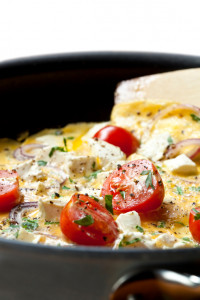 Pack Your Omelet Full Of Goodness
Pack Your Omelet Full Of Goodness
Omelets are one of those dishes that you can have for breakfast, lunch or dinner. The versatile omelet is low in calories too especially if you start with one egg and two egg whites (about 100 calories). Add the fillings of your choice and you have a protein packed meal that will satisfy your hunger.
Cheese Choices
Choose 1/4 cup of one of these cheese for your omelet.
Shredded Swiss
Shredded Cheddar
Crumbled Feta
Vegetables
Choose as many vegetables as you want because they are full of fiber and low in calories.
Chopped Broccoli
Sliced Mushrooms
Chopped Tomatoes
Proteins
Choose1/4 cup of these delicious proteins.
Smoked Salmon
Turkey Bacon
Ham
Optional
Choose one of these for a total treat.
Sautéed Potatoes
Avocado
Crème Fraiche

